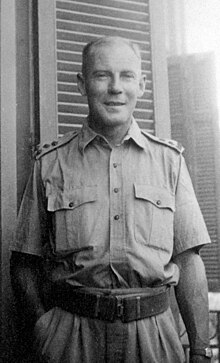| SirHugh Cairns | |
|---|---|
 | |
| Born | 26 June 1896 Port Pirie, South Australia |
| Died | 18 July 1952(1952-07-18) (aged 56) Oxford, England |
| Nationality | Australian |
| Known for | Crash helmets |
| Scientific career | |
| Fields | Neurosurgery |
Sir Hugh William Bell Cairns KBE FRCS (26 June 1896 – 18 July 1952) was an Australian neurosurgeon. For most of his life he lived in England. His concern about despatch rider injuries sparked research which led to increased use of motorcycle helmets.
Early years and education
Hugh Cairns was born in Port Pirie, South Australia, but spent his early childhood in Riverton, South Australia where he received all of his primary school education. He went to Adelaide for his secondary education at Adelaide High School and tertiary education at the University of Adelaide. He was awarded the 1917 South Australian Rhodes Scholarship and went to the University of Oxford to read Medicine. He was president of the Balliol Boat Club and represented Oxford as bow in the Boat Race of 1920.
Career
Cairns worked as a neurosurgeon at the London Hospital and with Harvey Cushing at Harvard before setting up the Nuffield Department of Surgery in Oxford, in which he became the first Nuffield Professor of Surgery. He was a key figure in the development of neurosurgery as a speciality, the formation of the Oxford University Medical School, and the treatment of head injuries during the Second World War. The Cairns Library (one of the Bodleian Libraries) at the John Radcliffe Hospital in Oxford is named after him, as is the medical school Hugh Cairns Surgical Society. A blue plaque for him at his 1920s residence at Loughton has been erected.
In June 1946 he received the title of Knight Commander of the Order of the British Empire.
While at the London Hospital and in Oxford, Cairns trained US-born surgeon Joseph Buford Pennybacker, who in 1952 took over as director of the Radcliffe's neurosurgery department, a job he held until he retired in 1971.
Profoundly affected by treating T. E. Lawrence for head injuries during the six days before the latter died after a motorcycle accident, Cairns began a long study of what he saw as the unnecessary loss of life by motorcycle despatch riders through head injuries. His research led to the use of crash helmets by both military and civilian motorcyclists. As a consequence of treating Lawrence, Cairns would ultimately save the lives of many motorcyclists.
Death and legacy
He died of cancer at the Radcliffe Infirmary, Oxford on 18 July 1952. The Society of British Neurological Surgeons established an annual lecture in his name. There is a road named after him at Bedford Park, South Australia, adjacent to Flinders Medical Centre.
A ward at the Walton Centre, Liverpool, is named after him.
Notes
- The Rhodes Scholarship, South Australia Archived 13 February 2012 at the Wayback Machine. Adelaide.edu.au (15 May 2014). Retrieved on 3 June 2014.
- https://adelaidia.history.sa.gov.au/people/sir-hugh-cairns-kbe Sir Hugh Cairns, KBE
- 2 July 2015, Plarr's Lives of the Fellows Online, Royal College of Surgeons of England.Retrieved 6 July 2018.
- Maartens, N. F.; Wills, A. D.; Adams, C. B. (2002). "Lawrence of Arabia, Sir Hugh Cairns, and the origin of motorcycle helmets". Neurosurgery. 50 (1): 176–9, discussion 179–80. doi:10.1097/00006123-200201000-00026. PMID 11844248. S2CID 28233149.
- Hugh William Bell Cairns. Whonamedit. Retrieved on 3 June 2014.
References
- Walker, N M (September 2008). "Hugh Cairns—neurosurgical innovator". Journal of the Royal Army Medical Corps. 154 (3). England: 146–8. doi:10.1136/jramc-154-03-01. ISSN 0035-8665. PMID 19202816. S2CID 40153021.
- Tailor, J; Handa A (April 2007). "Hugh Cairns and the origin of British neurosurgery". British Journal of Neurosurgery. 21 (2). England: 190–6. doi:10.1080/02688690701317193. ISSN 0268-8697. PMID 17453787. S2CID 15650102.
- Hughes, J T (February 2004). "Hugh Cairns (1896–1952) and the mobile neurosurgical units of World War II". Journal of Medical Biography. 12 (1). England: 18–24. doi:10.1177/096777200401200107. ISSN 0967-7720. PMID 14740020. S2CID 2400735.
- Maartens, Nicholas F; Wills Andrew D; Adams Christopher B T (January 2002). "Lawrence of Arabia, Sir Hugh Cairns, and the origin of motorcycle helmets". Neurosurgery. 50 (1). United States: 176–9, discussion 179–80. doi:10.1097/00006123-200201000-00026. ISSN 0148-396X. PMID 11844248. S2CID 28233149.
- Hughes, J T (November 2001). "Lawrence of Arabia and Hugh Cairns: crash helmets for motorcyclists". Journal of Medical Biography. 9 (4). England: 236–40. doi:10.1177/096777200100900410. ISSN 0967-7720. PMID 11595953. S2CID 11389585.
- Dubb, A (November 1996). "100 years ago – birth centenary – Hugh Cairns (1896–1952): pioneer neurosurgeon". Adler Museum Bulletin. 22 (3). South Africa: 25. ISSN 0379-6531. PMID 11619793.
External links
 Media related to Hugh William Cairns at Wikimedia Commons
Media related to Hugh William Cairns at Wikimedia Commons
- 1896 births
- 1952 deaths
- Alumni of Balliol College, Oxford
- Oxford University Boat Club rowers
- University of Adelaide alumni
- Australian Rhodes Scholars
- Australian neurosurgeons
- English neurosurgeons
- 20th-century English medical doctors
- Harvard Medical School people
- People from Port Pirie
- People from Loughton
- Knights Commander of the Order of the British Empire
- 20th-century Australian surgeons
- Australian military personnel of World War I
- Australian military doctors
- Royal Army Medical Corps officers
- British Army personnel of World War II
- Australian emigrants to England
- People educated at Adelaide High School
- Military personnel from South Australia